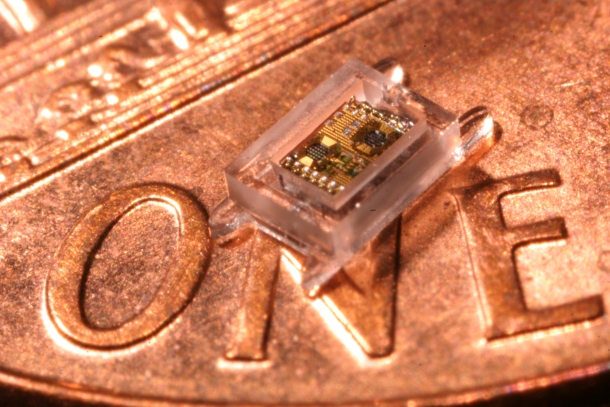Millimetre-sized medical chips will provide 'endless' uses

A computer system smaller than a pen tip has been developed to track the progression of glaucoma.
The one cubic millimetre system, announced on Tuesday by University of Michigan researchers at the International Solid-State Circuits Conference in San Francisco, is designed to be implanted into the eye. It combines a low-power microprocessor, pressure sensor, memory, thin-film battery, solar cell and wireless radio with antenna. It is designed to track changes in eyeball pressure in 15-minute increments.

A millimetre-sized medical chip can be implanted into the eye to track glaucoma. Photo credit: Greg Chen
"We're thinking about complete systems in which all the components are low-power and fit on the chip," Dennis Sylvester, a professor in the University of Michigan's department of electrical engineering and computer science, said in a statement. "We can collect data, store it and transmit it. The applications for systems of this size are endless."
The system relies on the third generation of the researchers' Phoenix chip, built in a 180nm CMOS fabrication process. The chip core contains a CPU, storage for data and programs, and a power management unit that recharges the internal battery from incident light falling on the eye. It uses a novel power gating architecture to cut standby power consumption.
Ultra-small scale
The system wakes every quarter of an hour to take measurements, consuming an average of 5.3 nanowatts. To maintain battery charge, the device requires exposure to 10 hours of indoor light each day, or 1.5 hours of sunlight.
The chip can store up to a week's worth of data, reporting it back via radio to a portable device held near the eye. A commercial version of the device is expected to be available "several years from now", the researchers wrote.
In a parallel announcement, University of Michigan researchers announced they had taken steps towards developing an ultra-small radio to allow communication between sub-millimetre scale devices.
The radio is less than one cubic millimetre in size, and uses its integrated antenna not only to transmit and receive signals but to set its frequency. Normally, radios use a sliver of quartz crystal to precisely set internal timings and frequencies, but these are very large compared to millimetre-scale circuits.
"Antennas have a natural resonant frequency for electrical signals that is defined by their geometry, much like a pure audio tone on a tuning fork," University of Michigan professor David Wentzloff said in a statement. "By designing a circuit to monitor the signal on the antenna and measure how close it is to the antenna's natural resonance, we can lock the transmitted signal to the antenna's resonant frequency." The system works in the 60GHz band, which has a wavelength of around 5 millimetres, and has been built within an area of 2.85 square millimetres.
The test system uses around 30MW and is thus still incompatible with millimetre-scale batteries, the researchers said, but they are addressing this problem.
In 2010 researchers announced that they were preparing to conduct human trials of a smart chip that would measure and suppress pain signals in the spinal cord from travelling to the brain.
Get the latest technology news and analysis, blogs and reviews delivered directly to your inbox with ZDNet UK's newsletters.